The Imaging Resource
Quick Review
Sony DSC-S600 Digital Camera
| Sony DSC-S600 QuickLook | ||
Review Date |
3/13/2006 | |
User Level |
Novice - Amateur | |
Product Uses |
Home / Travel | |
Digital Camera Design |
Point and Shoot | |
Picture Quality |
Very Good, 6.0-megapixel CCD |
|
Print Sizes |
11x17s, or 8x10s with heavy cropping | |
Availability |
March, 2006 | |
Suggested Retail Price (At introduction) |
$199 | |
Introduction
|
|||||||||
The Sony DSC-S600's shape and compact size rank it among the smaller Cyber-shots on the market, perfect for travel and leisurely outings. The camera definitely passes the "shirt pocket" test, and would even fit into a rather small handbag. The S600's compact profile isn't all the camera has to offer though. A 6.0-megapixel CCD and an all-glass, 3x zoom lens deliver sharp, clear pictures, suitable for printing as large as 11x17 inches, or to 8x10 with some cropping. There's also an email image size option that creates files with smaller pixel dimensions for sending over the Internet. Plus, the handful of preset Scene modes handle a wide range of common exposure situations, from beach scenes to night shots.
The Sony S600's 3x optical zoom lens has a focal length range from 5.1-15.3mm, the equivalent of a 31-93mm lens on a 35mm camera--a pretty wide angle relative to most competing models. Focus ranges from 4.75 inches (12 centimeters) to infinity in normal focus mode at full wide angle, and from 19.75 inches (50 centimeters) to infinity at full telephoto. The camera does not offer a separate macro lens setting, but the 4.75 inch minimum focal distance is pretty close as it is. The five-area Multi-Point AF system bases focus on one of five areas in the center of the frame. Through the camera's Record menu, however, you can opt for Center AF mode, which bases focus on a smaller central area of the frame. Also available, through the Setup menu, are two AF operating modes: Single and Monitoring. In Single AF mode, focus is set whenever the Shutter button is halfway depressed. Monitoring mode constantly adjusts focus before the Shutter button is halfway depressed, which then locks focus. (Note though that Monitor mode is likely to drain battery more quickly than the others because the focus motor and image processor are constantly at work.)
The camera's AF illuminator helps the camera focus in dark conditions (even in total darkness), and works well with the Twilight scene modes. In addition to the 3x optical zoom, the S600 also features up to 5.2x Smart Zoom, Sony's current implementation of "digital zoom." Unlike most other digital zoom functions, Sony's Smart Zoom does not resample the image, so no image deterioration occurs as a result: Pixels are simply cropped from the central portion of the sensor's image, and packaged as a separate, smaller file. When the optical zoom reaches 3x, Smart Zoom takes over, if enabled in the Setup menu. The maximum total magnification available is 4.1x for 3 megapixel images, 5.2x for 2 megapixel ones, 13x for VGA ones, and 4.4x for HDTV. (Note though, that as a result, "Smart Zoomed" images will always be restricted to sizes smaller than the camera's maximum resolution.) There's also a Precision Digital Zoom option, which digitally enlarges the image to a maximum of 6x (that is, a 2x digital magnification in addition to the 3x optical zoom) regardless of the camera's resolution setting, albeit with deteriorated quality due to the digital "stretching" of the image.
The Sony S600 has a real-image optical viewfinder and a large, 2.0-inch color LCD monitor for framing shots. An information display on the LCD monitor reports a handful of camera settings (including aperture and shutter speed). We found the optical viewfinder to be quite tight, showing only about 80% of the final frame, but the LCD monitor proved very accurate at close to 100%.
Exposure is automatically controlled at all times on the Sony DSC-S600, great for novices looking for simplicity. An On/Off button on top of the camera powers the camera on, and a small Mode switch on the back selects between Playback, Still Record, and Movie modes. Within Still Record mode, you can select between Automatic, Program, and seven preset Scene modes, through the Record menu. The Automatic setting takes away all user control, with the exception of flash, macro, and resolution. Program mode also automatically sets aperture and shutter speed, but gives you control over a number of other exposure variables. The available Scene options include High Sensitivity, Twilight, Twilight Portrait, Soft Snap, Landscape, Beach, and Snow modes. The High Sensitivity mode raises the equivalent ISO (light sensitivity) setting so you can shoot without the flash low lighting. (This does increase image noise though.) Both Twilight modes optimize the camera for low-light shooting by allowing shutter times as long as one second, while Landscape mode sets the camera up for shooting distant subjects. Soft Snap mode warms skin tones and sets focus to slightly soft. Beach mode ensures that blue tones are recorded accurately in lakeside or seaside photos, while Snow mode enhances saturation and adjusts exposure, to prevent loss of color in bright white snowscapes.
By default, the Sony DSC-S600 employs a Multi-Metering mode to determine exposure, which reads the exposure from five areas across the frame. For higher-contrast subjects or more pin-pointed readings, the S600 also offers a Spot metering mode via the Metering button on the rear panel. Exposure Compensation is adjustable from -2 to +2 exposure values (EV), in one-third-step increments. You can also adjust the camera's sensitivity to 80, 100, 200, 400, 800, or 1,000 ISO equivalents, or use the Auto setting. The S600's adjustable White Balance setting offers Auto, Daylight, Cloudy, Fluorescent, and Incandescent modes, handling a variety of common light sources. Under the Picture Effects setting, you can record images in sepia or black and white. The camera also offers Sharpness, Saturation, and Contrast adjustments. The Sony S600's flash operates in Forced, Suppressed, Auto, Red-Eye Reduction, and Slow-Sync modes, and an intensity adjustment controls flash output (in an increment of one unit, higher or lower than normal). Metering and autofocus options vary in the different Scene modes, based on what would be appropriate for the type of subjects each mode corresponds to.
In Movie exposure mode, the camera captures either 640 x 480 in Fine (30fps) or Standard (16fps) modes, or 160 x 112-pixel resolution moving images with sound for as long as the memory card has storage space available. (Note that 640 Fine mode requires a Memory Stick Pro card, while the card shipped with the camera is a standard, non-Pro Memory Stick.) The Sony DSC-S600 also offers a Multi Burst mode, which captures an extremely rapid 16-frame burst of images, at a selectable rate of 7.5, 15, or 30 frames per second. Multi Burst shots are played back as a slow-motion animation on the camera, but appear as a single large file with 16 sub-images in it when viewed on a computer. (This would be a fun way to catch someone crossing a finish line during a race, or to analyze golf and tennis swings.) A Self-Timer mode provides a 10-second delay between the time the Shutter button is pressed and the time that the camera actually takes the picture, giving the photographer time to run around and get into the picture. Also available on the Sony S600 is Burst mode, which records five full resolution images in quick succession, while holding down the Shutter button. As many as 100 VGA images can be recorded before the buffer is full.
Images are stored on Sony's Memory Stick Duo media (not included with the camera) or its 32MB internal memory, and they can be downloaded via a speedy USB 2.0 connection to a PC or Macintosh computer. The S600 is powered by two AA-type batteries, and comes with a set of alkaline single use cells. Read my NiMH battery shootout page to see which batteries currently on the market are the best, and see my review of the Maha C-204W NiMH battery charger, my current favorite.
Basic Features
- 6.0-megapixel CCD delivering image resolutions of 2,816 x 2,112 pixels.
- 3x zoom lens (equivalent to a 31-93mm lens on a 35mm camera).
- 2x digital "Precision" zoom; up to 13x "Smart" Zoom (at VGA resolution).
- Real-image optical viewfinder.
- 2.0-inch color LCD monitor.
- Automatic exposure control.
- Built-in flash with five modes and an intensity adjustment.
- Sony Memory Stick Duo storage (not included).
- 32MB internal memory.
- USB computer connection.
- Uses two AA type batteries for power.
- Software for Mac and PC.
Special Features
- High Sensitivity, Twilight, Twilight Portrait, Soft Snap, Landscape, Beach, and Snow modes
- Movie (with sound) recording mode.
- Multi-Burst slow motion mode and Burst high speed mode.
- Email (VGA) resolution mode.
- Shutter speeds from 1/2,000 to one second depending on the exposure mode.
- Aperture range of f/2.8 to f/5.1.
- Creative Picture Effects menu.
- Image Sharpness, Saturation, and Contrast adjustments.
- Self-timer for delayed shutter release.
- Macro (close-up) lens adjustment.
- Spot and Multi metering modes.
- Adjustable AF area and two AF modes.
- Auto ISO setting or 80, 100, 200, 400, 800, and 1,000 ISO equivalents.
- White balance (color) adjustment with five options.
- DPOF (Digital Print Order Format) and PictBridge printing compatibility.
User Recommendation
With its compact, pocket-friendly size and straightforward interface, the Sony Cyber-shot DSC-S600 is well-suited for beginners or anyone who doesn't want to fuss around with camera controls too much. Essentially a point-and-shoot digital camera, the S600 does offer a handful of creative options and seven preset scene modes to handle variety of shooting situations. It's comfortable in the hand, with well laid-out controls, and takes good pictures with sharp, clear details. The Sony DSC-S600 would make a great "family" camera, where users with a range of skill levels need to share the same camera. It would also make a great "pocket camera" for more experienced users.
The Sony DSC-S600 is compact and stylish, pocket-friendly, and ready to go just about anywhere. Its silvery plastic body is only slightly longer than a typical business card, and nearly the same height, top to bottom. Measuring just 3.93 x 2.00 x 1.44 inches (99.9 x 52 x 36.8 millimeters) and weighing only 6.4 ounces (181 grams) with the battery and memory card installed, the S600 fits easily into small pockets or purses. When not in use, the telescoping zoom lens retracts neatly inside the body, and a small plastic leaf shutter automatically closes over the lens to protect it. Outfitted with the accompanying wrist strap, it's quick on the draw and easy to hold.
Despite its small size, the Sony DSC-S600's elongated shape provides plenty of room to extend two average-size fingers comfortably across the front and top of the camera, without blocking the lens or any camera controls. By making the camera thin but long, Sony kept the S600 quite compact, yet avoided the lack of finger space that plagues many ultra-small digital cameras. The 3x, 5.1-15.3mm zoom lens (equivalent to a 31-93mm zoom on a 35mm camera), dominates the right side of the front of panel, with a small and very bright orange lamp just above and to the right of it, to help with focusing in low-light conditions. (This lamp also blinks when the self-timer is in use, to let you know when the camera is about to snap the picture.) A slightly larger window for the optical viewfinder actually cuts into the other side of the lens area. The built-in electronic flash sits just next to the Sony logo. A thin, sculpted, vertical ridge serves as the only fingergrip on the front of the camera, but is comfortable for two fingers to grasp.
The right side of the camera (as viewed from the rear) houses the battery compartment, protected by an easy to open, hinged plastic door. A small plastic door-within-a-door (actually on the bottom side of the camera) pops open to allow easy connection of the charger cable, since the camera comes with no external battery charger. Above the door is a small eyelet for attaching the wrist strap. Also on this side of the camera is a tiny LED, on the very left-most edge, that lights whenever the camera is accessing the memory card.
The left side is fairly smooth, with a rounded surface to slightly follow the contour of the lens barrel and a logo declaring the lens zoom capability. At the very bottom of this side is the USB connector compartment, protected by a flexible, rubbery flap that remains tethered to the camera.
The camera's top panel includes only the Shutter button and a small Power button, which is surrounded by a green power LED. To the left of the Power button is the camera's microphone. Also from the top view, you can see the Mode switch, angled down toward the rear panel.
The camera's rear panel holds the remaining camera controls and function buttons, along with a 2.0-inch color LCD monitor for previewing and playing back images, and the optical viewfinder window. The LCD display reports a variety of camera and exposure settings, including the aperture and shutter speed settings (a nice bonus for those interested in how the camera will expose the image, even though neither variable is user adjustable) and approximate battery capacity. The optical viewfinder is located in the top left corner, and has two LED lamps along the right edge of the window, each of which reports the current status of various camera functions. The camera's Zoom control buttons are in the upper right corner, conveniently located right above a small inset area for better thumb traction when holding the camera. In the lower right corner is a Four-way Multicontroller rocker button, with small arrows pointing in four directions (Up, Down, Left, and Right) and a set button in the middle. Each serves multiple functions, navigating onscreen menus scrolling between captured images in playback mode, or activating different camera functions (Flash, Self-Timer, Quick Review, and Macro).
Upper left of the Arrow pad is the Menu button; lower left is the LCD Display button; and lower right is the Image Resolution / Erase button. A Mode switch rests between the Zoom controls and viewfinder, and controls the main operating mode.
Finally, the S600's reasonably flat bottom holds the threaded (metal) tripod screw mount, a speaker for audio playback, and the Memory Stick compartment. While most users of the Sony S600 probably won't care, I was pleased to see that I could change the battery and memory card without removing my tripod mounting plate from the camera's bottom. (The slight downside though, is that the camera sits slightly tilted on many tripod mounts.)
Operating the Sony DSC-S600 is pretty straightforward, as exposure remains under automatic control and user options are somewhat limited. The Mode switch on the back of the camera controls the main operating modes, with options for Playback, Still Record, and Movie. In all image capture modes, the Sony S600 provides an onscreen LCD menu (activated by the Menu button), with a variety of options for adjusting image quality or adding special effects. The four arrows of the Multicontroller are used to scroll through menu options, while the button in the center of the pad functions as the OK button to confirm selections. The arrow keys of the Multicontroller also serve to adjust flash, metering, self-timer, and quick review modes, or they can be used to scroll through captured images in Playback mode. An Image Resolution button calls up a list of the available resolution settings, removing this item from the main menu system for easier access. The Zoom controls in the top right corner of the back panel adjust both optical and digital zoom (when activated through the Setup menu). The DSC-S600 is so straightforward, you should be snapping pictures almost immediately after opening the box.
Record-Mode Display
In record mode, the LCD monitor displays the subject with a good amount of overlaid information, indicating battery remaining (graphically), flash mode, focus area, autofocus mode setting, any currently-selected exposure compensation setting, ISO setting, the current size/quality setting, and number of images that can be stored on the remaining Memory Stick space at the current size/quality. Half-pressing the Shutter button causes the camera to display the shutter speed and aperture setting it has chosen for the current lighting conditions. (While you can't change these directly, it's very nice to know what settings the camera has selected.) Pressing the Display button to the right of the LCD once removes the information overlay (but leaves the focus brackets and flash mode icons), and pressing it a third time turns the LCD off entirely. Pressing it a fourth time restores the default display.
Playback-Mode Display
In Playback mode, the default image display shows the most recently captured image, with a modest information overlay present. Pressing the Display button once adds the exposure information to the overlay, pressing it again removes the information overlay entirely, and pressing it a third time turns off the LCD altogether. Pressing the wide-angle side of the zoom lever takes you to a display showing images on the Memory Stick in groups of nine small thumbnails. (You can navigate a yellow outline cursor over these thumbnails by using the four arrow keys. Pressing the telephoto side of the zoom lever will bring the currently-selected image up full-screen.) Pressing the telephoto side of the zoom lever when viewing an image full-size on the LCD screen will zoom in on the image, up to a maximum magnification of 5x. This is a useful level of magnification, handy for checking focus and precise framing.
External Controls
Power Button: Located just left of the Shutter button on the camera's top panel, this button turns the camera on and off. A green LED surrounds the button, and lights whenever the camera is powered on.
Shutter Button: Round and smooth, on the top panel, this button sets focus and exposure when halfway pressed, and fires the shutter when fully pressed.
Mode Switch: Just above the LCD monitor and angled down slightly from the top panel, this sliding switch sets the camera's operating mode, offering Playback, Still Record, and Movie modes. (See menus and descriptions below.)
Zoom Control Buttons: Positioned in the top right corner of the rear panel, these two buttons control optical zoom and, when enabled via the Setup menu, Sony's "Smart Zoom" and "Precision Zoom" options.
In Playback mode, this button controls the digital enlargement of a captured image, which can go as high as 5x. (Very handy for checking focus or the expressions on people's faces in group shots.) Also in Playback mode, the wide-angle end of the button activates the Index Display mode, which displays as many as nine thumbnail images on the screen at one time.
Menu Button : The top-most button adjacent to the right side of the LCD monitor, this button activates the settings menu in any camera mode. The Menu button also dismisses the menu display.
Four-Way Multicontroller and OK Button: Located just to the right of center on the rear panel, this rocker control features four arrows, each pointing in a different direction (up, down, left, and right), and a Set or OK button in the middle (Sony describes it in the S600's manual simply by its shape: a dot). In all settings menus, these arrow keys navigate through menu options. Pressing the center of the button confirms selections.
In Record mode, the Up button controls the Flash mode, cycling through Auto, Forced, Slow-Sync, and Suppressed (Off) modes. The Right arrow selects the metering mode (Normal or Spot), and the Left arrow accesses the Quick Review mode, which displays the most recently captured image on the screen. The Down arrow accesses the Self-Timer mode.
In Playback mode, the Right and Left arrows scroll through captured images. When Playback zoom is enabled, all four arrows scroll around within the enlarged view, while pressing the center button returns to the normal, 1x display.
Display / LCD On/Off Button : Down and to the left from the Multicontroller, this button controls the LCD display, cycling through the image with information display, the image with limited information display, and no image display at all (in all Record modes). In Playback mode, it cycles through the same series.
Image Resolution / Erase Button: Tucked in the lowest right corner, this button displays the available resolutions in any record mode. Choices are 6M (2,816 x 2,112), 3:2 ratio (2,816 x 1,872), 3M (2,048 x 1,536), 2M (1,632 x 1,224), VGA (640 x 480), and HDTV 16:9 (1,920 x 1,080). Movie resolutions are 640 x 480-, and 160 x 112-pixels.
In Playback mode, this button lets you erase the currently displayed image.
Camera Modes and Menus
Playback Mode: Playback mode is noted on the Mode switch with the traditional Playback symbol (a triangle enclosed within a rectangular outline). In this mode, you can scroll through captured images, delete them, write-protect them, and set them up for printing on PictBridge-compatible printers. You can also copy, resize, and rotate images.
Still Record Mode: Marked on the Mode switch with a camera icon, this mode sets up the camera to capture still images. Within this mode, you can opt for Auto or Program exposure modes, or choose from one of seven preset "scenes" through the Record menu. (Scene modes include High Sensitivity, Twilight, Twilight Portrait, Soft Snap, Landscape, Beach, and Snow.)
Movie Mode: A filmstrip icon marks this mode on the Mode switch. In Movie mode, you can record moving images and sound, for as long as the Memory Stick Pro Duo or internal memory has space. Resolution and quality choices are 640 x 480 in Fine or Standard mode, or 160 x 112-pixels. Fine mode records at 30 frames per second while Standard mode records at 15 frames per second. While recording, a timer appears in the LCD monitor to let you know how many minutes and / or seconds are remaining on the memory, and how long you've been recording, so you'll have some idea of how much time you have left. Recording in 640 x 480 Fine mode is only available with a Memory Stick PRO Duo card, but the speed of the PRO cards permits continuous recording up to the capacity limit of the card itself, with no restrictions imposed due to buffer memory limitations. (The S600 can likewise record to the limits of card capacity in its lower-quality movie modes on standard Memory Stick Duo cards.)
Record Menu: Available in the Record modes by pressing the Menu button, the Record menu offers the following options (some options are not available in all modes):
Camera: Offers Auto, Program, High Sensitivity, Twilight, Twilight portrait, Soft Snap, Landscape, Beach, and Snow modes.
- EV (Exposure Compensation): Increases or decreases the overall exposure from -2 to +2 exposure values (EV) in one-third-step increments.
- Focus: Sets focus control to Multi or Center AF modes.
- White Balance: Adjusts the overall color balance of the image, to suit the light source. Options are Auto, Daylight, Cloudy, Fluorescent, and Incandescent.
- ISO: Adjusts the camera's light sensitivity. Options are Auto, or 80, 100, 200, 400, 800, or 1,000 ISO equivalents.
- P.Quality: Sets image compression to Standard or Fine.
- Mode: Sets capture mode, Normal (single), Burst, and Multi-burst.
- Interval: When in Multi-burst mode, sets the capture interval between 1/7.5, 1/15, and 1/30.
- Flash level: Sets flash power to +1, Normal, or -1.
- Picture Effects: Offers two creative shooting modes:
- Black and White: Takes photos in monochrome.
- Sepia: Records an image in monochrome sepia tone.
- Saturation: Adjusts the overall color saturation with plus, normal and minus settings.
- Contrast: Alters the level of contrast in images with plus, normal and minus settings.
- Sharpness: Controls the overall image sharpness and softness with plus, normal and minus settings.
- Setup: Displays the main Setup menu:
- Camera 1:
AF Mode: Selects Single or Monitor autofocus modes. In Monitor mode, the AF system is constantly working, until you press the shutter. This may help maintain focus on moving subjects.
- Digital Zoom: Selects Smart Zoom or Precision Zoom settings, or disables all digital zoom.
- Red Eye Reduction: Enables or disables the Red Eye Reduction flash mode, affecting both Auto and Forced flash modes.
- AF Illuminator: Turns the AF Assist light on or off. If on, the light automatically illuminates in dark shooting conditions.
- Auto Review: Immediately plays the captured image onscreen for two seconds.
- Internal Memory Tool (not shown):
- Format: Formats the internal memory, erasing all files (even protected ones).
- Memory Stick Tool:
Format: Formats the Memory Stick, erasing all files (even protected ones).
- Create REC Folder: Creates a new folder for recording images.
- Change REC Folder: Changes the folder that images are recorded to.
- Copy: Copies files from the internal memory to the Memory Stick.
- Setup 1:
Beep: Controls the camera's beep sounds, turning them on or off. A Shutter option enables only the shutter sound.
- Language: Selects among Italian, French, Spanish, Chinese, Japanese, or English for the menu language.
- Initialize: Resets the camera settings to their defaults.
- Setup 2:
File Number: Chooses between Series (continuing the shot number infinitely) or Reset, which resets the frame number by folder.
- USB Connect: Sets the USB connection type to PictBridge, PTP, Mass Storage, or Auto.
- Clock Set: Sets the camera's internal clock and calendar.
- Camera 1:
Playback Menu:
(No screenshots, icons only in first level of Playback Menu.)
- Folder: Selects the folder for playing back images.
- Protect: Write-protects the current image (or removes protection), preventing it from being deleted or manipulated in any way except with card formatting.
- DPOF: Marks the current image for printing on a DPOF device. Also removes the print mark.
- Print: Prints the current image.
- Slide: Plays back images in an automatic slide show. You can set the time interval and whether or not the sequence of images repeats.
- Resize: Resizes the image to 2,816 x 2,112; 2,048 x 1,536; 1,632 x 1,224; or 640 x 480 pixels. (When an image is resized, the original image is left in place, and a new copy is made at the selected size.)
- Rotate: Rotates the image 90 degrees clockwise or counterclockwise.
- Divide: Allows you to trim material from the beginning or end of a recorded movie, or to extract an interesting bit of action from the middle of a longer clip. (Very handy.)
- Setup: Displays the same Setup menu as in Record mode.
- Trimming: Lets you crop an image and resave it as a separate file.
In the Box
Included with the Sony DSC-S600 digital camera are the following items:
- Wrist strap..
- Two alkaline batteries..
- USB cable.
- Software CD containing the Cyber-Shot imaging software and USB drivers.
- Set of rechargeable batteries and charger. (Read my NiMH battery shootout page to see which batteries currently on the market are the best, and see my review of the Maha C-204W NiMH battery charger, my current favorite.)
- Larger capacity Memory Stick PRO Duo (at least 256MB, but 512 is warranted, particularly for recording movie clips)
- Carrying case
Recommended Software: Rescue your Photos!
Just as important as an extra memory card is a tool to rescue your images when one of your cards fails at some point in the future. I get a lot of email from readers who've lost photos due to a corrupted memory card. Memory card corruption can happen with any card type and any camera manufacturer, nobody's immune. A surprising number of "lost" images can be recovered with an inexpensive, easy to use piece of software though. Given the amount of email I've gotten on the topic, I now include this paragraph in all my digital camera reviews. The program you need is called PhotoRescue, by DataRescue SA. Read our review of it if you'd like, but download the program now, so you'll have it. It doesn't cost a penny until you need it, and even then it's only $29, with a money back guarantee. So download PhotoRescue for Windows or PhotoRescue for Mac while you're thinking of it. (While you're at it, download the PDF manual and quickstart guide as well.) Stash the file in a safe place and it'll be there when you need it. Trust me, needing this is not a matter of if, but when... PhotoRescue is about the best and easiest tool for recovering digital photos I've seen. (Disclosure: IR gets a small commission from sales of the product, but I'd highly recommend the program even if we didn't.) OK, now back to our regularly scheduled review...
See the specifications sheet here.
Cycle times, shutter lag, battery life, etc. can be found here.
See my test images and detailed analysis here. The thumbnails below show a subset of my test images. Click on a thumbnail to see the full-size photo.
"Gallery" Photos
For those readers interested in a set of less "standardized" photos from the Sony S600, see the Sony DSC-S600 photo gallery of more pictorial shots captured with the S600.
We ran the Sony Cyber-shot DSC-S600 through our usual battery of tests, and have summarized our findings here. To see the full set of our test images, with explanations of what to look for in them, see the Sony Cyber-shot DSC-S600 Sample Pictures page. For a complete listing of all our test and "gallery" shots, go to the Thumbnails page.
A collection of more random, pictorial images can be found in the Sony Cyber-shot DSC-S600 Photo Gallery.
Not sure which camera to buy? Let your eyes be the ultimate judge! Visit our Comparometer(tm) to compare images from the Sony DSC-S600 with those from other cameras you may be considering. The proof is in the pictures, so let your own eyes decide which you like best!
Lens
Zoom
A 3x optical zoom range, a bit wider angle than most, with good performance.
31mm |
93mm |
2x Digital Zoom |
The Sony DSC-S600 zooms over the equivalent of a 31-93mm range, providing a slightly wider angle than most cameras. Results are good at full wide angle, though some softening is noticeable in the corners. Details are quite sharp at full telephoto, though again there is a little softening in the corners. The 2x Precision Digital zoom takes it out to 6x total with fairly good results, better than traditional digital zoom but still quite noticeably softer than with optical zoom.
Macro
A bit larger than average macro area with good detail and high resolution. Flash illumination is uneven however, with dark shadows in the corners.
| Standard Macro | Macro with Flash |
The Sony DSC-S600's macro setting captured a bit larger than average minimum area, measuring 4.24 x 3.18 inches (108 x 81 millimeters). However, detail is quite strong and resolution high. There's only minimal softening in the corners from the lens (most cameras have some softening in the corners in macro mode), though the Auto white balance setting produced a greenish color balance with the daylight-balanced tungsten lighting we use in this shot. The flash throttles down well, but its light doesn't reach the corners of the frame. (Plan on using external lighting for your closest macro shots with the S600.)
Distortion
Higher than average barrel distortion, a fair bit of pincushion as well.
This is the tendency for the lens to bend straight lines outward (like a barrel--usually at wide angle) or inward (like a pincushion--usually at telephoto). The Sony Cyber-shot S600's 1.05% barrel distortion at wide angle is higher than average, and quite noticeable in its wide angle images. At the telephoto end, the S600's 0.5% pincushion is also high, much more than I'd ideally like to see.
| Barrel distortion at 31mm is 1.05% |
| Pincushion at 93mm is 0.5% |
Chromatic aberration
High at wide angle, but decreases fairly rapidly as you move away from the corners. Little or none at telephoto.
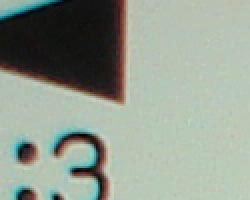 |
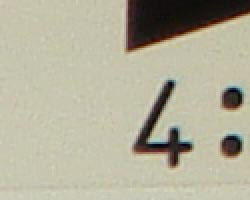 |
| Wide: high and bright, top left @ 200% | Tele: quite low, top right @200% |
Chromatic aberration is rather high at wide angle, showing about 6-7 pixels of bright coloration on either side of the target lines, but diminishes fairly rapidly as you move away from the corners of the image. There's little or no chromatic aberration at telephoto focal lengths. (This distortion is visible as a very slight colored fringe around the objects at the edges of the field of view on the resolution target.)
Corner Sharpness
Moderate softening in the corners of the frame, with the strongest results in the left corners at both ends of the zoom range.
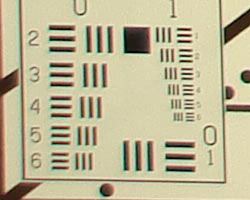 |
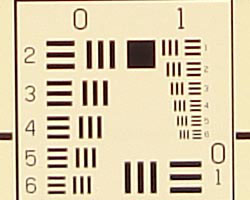 |
| Wide: soft in the lower left corner. | Wide: sharp at center. |
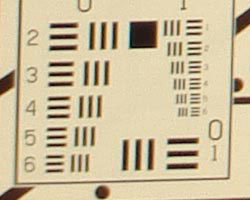 |
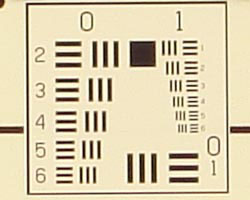 |
| Tele: soft in the lower left corner. | Tele: better at center. |
The Sony DSC-S600 produced soft corners in a few shots, with the greatest softening occurring in the left corners at both wide angle and telephoto. The softening is less than we've seen in many cameras though, somewhat better than average.
Sensor
Exposure and White Balance
Indoors, incandescent lighting
A moderate warm cast with both Auto and Incandescent white balance settings, Incandescent results are within acceptable limits though. About average exposure accuracy.
| Auto White Balance +1.0 EV | Incandescent WB +1.0 EV |
Color balance indoors under incandescent lighting was just a bit warm and reddish in Auto white balance mode, while the Incandescent setting resulted in a less strong yellow color balance (the more pleasing of the two). While more than we like to see, the coloration in Incandescent mode will probably be acceptable to most users. The DSC-S600 required a +1.0 EV exposure compensation boost to get a good exposure, which is about average for this shot. Overall color is a little dark and yellow here, making the blue flowers very dark and purplish. (A very common outcome for this shot.) Our test lighting for this shot is a mixture of 60 and 100 watt household incandescent bulb, a pretty yellow light source, but a very common one in typical home settings here in the US. The S600's handling of incandescent lighting is good to average relative to other cameras we've tested.
Outdoors, daylight
Slightly warm, dark overall color. Better than average exposure accuracy outdoors.
| Auto White Balance, +0.3 EV | Auto White Balance, Auto Exposure |
Outdoor shots generally showed accurate exposure, though with rather high contrast and very dark shadows. Exposure accuracy overall was better than average for these shots, the camera requiring less exposure compensation than we're accustomed to seeing with consumer digicams.
See full set of test images with explanations
See thumbnails of all test and gallery images
Resolution
High resolution, 1,200 - 1,300 lines of strong detail.
Our laboratory resolution chart revealed sharp, distinct line patterns down to about 1,300 lines per picture height horizontally, though only about 1,200 lines vertically. Extinction occurred around 1,800 horizontally, but closer to 1,700 lines vertically. (The camera also produced slight color artifacts at lower line frequencies, visible in the full-sized res target shots.) Use these numbers to compare with other cameras of similar resolution, or use them to see just what higher resolution can mean in terms of potential detail. Beware that while you might be able to make out what appear to be distinct lines at numbers higher than those we've mentioned here, but the camera is just doing its best to continue interpreting the lines. If you zoom in and follow them from the wider portions, you'll see the lines converge and reappear several times, so the lines you see at 1,500 and higher are really only artifacts generated by the camera's imaging system.
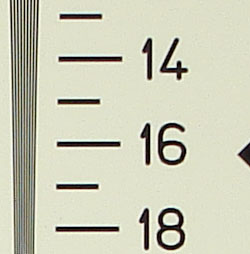 |
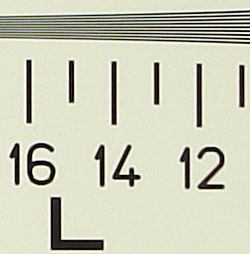 |
| Strong detail to 1,300 lines horizontal | Strong detail to 1,200 lines vertical |
See full set of test images with explanations
See thumbnails of all test and gallery images
Sharpness & Detail
Fairly sharp images, relatively slight blurring of detail from noise suppression.
The Sony DSC-S600's images are sharp overall, though with some noticeable over-sharpening and edge enhancement, particularly in high-contrast shots like the outdoor crop above. (Edge enhancement creates the illusion of sharpness by enhancing colors and tones right at the edge of a rapid transition in color or tone.) Still, results are pretty good, even with the heightened contrast.
Noise-suppression systems in digital cameras tend to flatten-out detail in areas of subtle contrast. The effects can often be seen in shots of human hair, where the individual strands are lost and an almost "watercolor" look appears. The crop at far right shows this, with darker areas of Marti's hair showing only limited detail, even though individual strands are visible against her cheek in the uncropped image. (Note though, that the 6 megapixel resolution of the Sony S600 means that the loss of detail seen above is almost invisible on even 8x10 inch prints.)
ISO & Noise Performance
Moderate noise at the normal sensitivity settings, very high noise that blurs detail at the highest settings. ISO 400 shots are (marginally) usable to about 8x10 inches when printed.
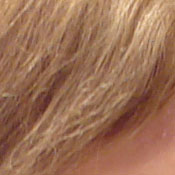 |
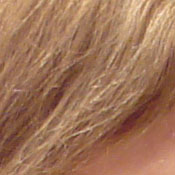 |
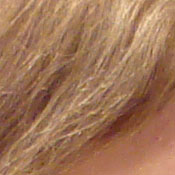 |
| ISO 80 | ISO 100 | ISO 200 |
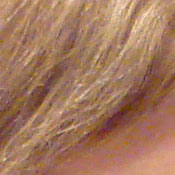 |
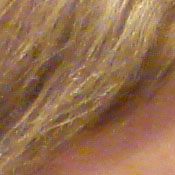 |
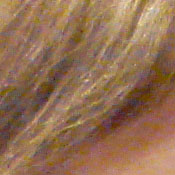 |
| ISO 400 | ISO 800 | ISO 1,000 |
The Sony DSC-S600's lower ISO settings produced moderate noise and relatively good detail in the dark areas. As the ISO setting increased, so did the noise level and the amount of blurring from the anti-noise processing. Shots taken at ISO 400 show quite a bit of color noise on-screen, but prints from them would probably be acceptable to most consumers (if marginally so) at print sizes as large as 8x10 inches. At ISO 800 and 1,000, noise increases to very high levels. ISO 800 shots are probably only usable at sizes of 5x7 inches and below, while ISO 1,000 ones are best used for 4x6 prints only.
Extremes: Sunlit and low light tests
High resolution with good overall detail, but high contrast and limited highlight and shadow detail. Moderate low-light performance, capable of capturing bright images under average city street lighting and slightly darker conditions.
| Normal | +0.3EV | +0.7EV |
Sunlight:
Because digital cameras are more like slide film than negative film (in that they tend to have a more limited tonal range), we test them in the harshest situations to see how they handle scenes with bright highlights and dark shadows, as well as what kind of sensitivity they have in low light. The shot above is designed to mimic the very harsh, contrasty effect of direct noonday sunlight, a very tough challenge for most digital cameras. (You can read details of this test here.)
The Sony DSC-S600 responded to the deliberately harsh lighting in the test above by producing very contrasty images with very deep shadows. The exposure at +0.3 EV is a little dark in the midtones and lighter shadow areas, but at +0.7 EV, the highlights are way too bright and distracting. (In "real life" though, be sure to use fill flash in situations like the one shown above; it's better to shoot in the shade when possible.) Though contrast is high and the shadows quite dark, there's moderate shadow detail present (albeit with some visible noise suppression).
Low light:
Our low light testing revealed some limitations in the lens and sensor's ability to gather and process light, but the Sony DSC-S600's performance here should be entirely adequate for most consumers. With a maximum shutter time of only one second, the DSC-S600 isn't really intended for serious low-light shooting. However, the camera is able to capture bright images under the equivalent of average city street lighting, at most of its ISO settings. The camera's autofocus system worked well, able to focus on the subject down to the darkest light levels we test at with its AF-assist light activated, though only to about 1/4 foot-candle without AF assist.
NOTE: This low light test is conducted with a stationary subject, and the camera mounted on a sturdy tripod. Most digital cameras will fail miserably when faced with a moving subject in dim lighting. (For example, a child's ballet recital or a holiday pageant in a gymnasium.) For such applications, you may have better luck with a digital SLR camera, but even there, you'll likely need to set the focus manually. For information and reviews on digital SLRs, refer to our SLR review index page.
Color
Saturation & Hue Accuracy
Somewhat oversaturated reds, but generally accurate color.
The other important part of color rendition is hue accuracy. Hue is "what color" the color is. The Sony S600 did fairly well in this respect, introducing small hue shifts, but ones that were well within an acceptable range. Most users should be fairly pleased with the S600's performance in this area.
(See our Sony Cyber-shot DSC-S600 Photo Gallery for more shots taken with the camera.)
Viewfinder
Coverage
A tight optical viewfinder, but good accuracy from the LCD monitor.
| 31mm eq., optical viewfinder | 93mm eq., optical viewfinder |
| 31mm eq., LCD monitor | 93mm eq., LCD monitor |
The DSC-S600's optical viewfinder was quite tight, showing only about 78% frame accuracy at wide angle, and about 80% at telephoto. However, the LCD monitor proved much more accurate, showing close to 100% accuracy at both wide angle and telephoto.
Flash
Coverage and Range
Slightly limited flash range, though exposure boost helps at close range.
| 31mm equivalent | 93mm equivalent |
| Normal Flash, Default Exposure | Normal Flash +0.7 EV |
Flash coverage was rather uneven at wide angle but very good at telephoto. In the Indoor test, the DSC-S600's flash underexposed our subject at its default setting, but only required a +0.7 EV exposure compensation adjustment to get bright results, less than the +1.0 EV boost most cameras need. Overall color balance is a little warm from the background incandescent lighting, but color is pretty good.
| 8 ft | 9 ft | 10 ft | 11 ft | 12 ft | 13 ft | 14 ft |
1/40 sec f5.1 ISO 100 |
1/40 sec f5.1 ISO 100 |
1/40 sec f5.1 ISO 100 |
1/40 sec f5.1 ISO 100 |
1/40 sec f5.1 ISO 100 |
1/40 sec f5.1 ISO 100 |
1/40 sec f5.1 ISO 100 |
Results on the flash range test are fairly consistent and bright to about 11 feet at ISO 100, with moderate falloff from that point on.
Output Quality
Print Quality
Good print quality, great color, very usable 13x19 inch prints. ISO 400 images are a bit soft and noisy at 8x10 but should be acceptable to most consumers.
Testing hundreds of digital cameras, we've found that you can only tell just so much about a camera's image quality by viewing its images on-screen. Ultimately, there's no substitute for printing a lot of images and examining them closely. For this reason, we now routinely print sample images from the cameras we test on our Canon i9900 studio printer, and on the Canon iP5000 here in the office. (See the Canon i9900 review for details on that model.)
With the Sony DSC-S600, we found that it had enough resolution to make good-looking (if slightly soft) 13x19 inch prints. At 11x14, its prints were quite sharp, and 8x10s were sharp even with significant cropping. At high ISO, image noise levels increased, but 8x10 prints were still (marginally) usable as high as ISO 400. ISO 800 shots were quite a bit noisier, a bit marginal at 5x7 inches. ISO 1000 shots were really only usable for 4x6 snapshots.
Color-wise, the Sony S600's images looked good when printed on the i9900, avoiding the oversaturated look of many consumer digital cameras (apart from strong reds), without appearing dull in the process. If you dislike the over-amped color of many consumer cameras these days, you should find the Sony S600's photos very appealing.
Timing and Performance
Sony Cyber-shot DSC-S600 Timing
Better than average speed for a consumer camera.
| Startup/Shutdown: | |
| Power On to first shot | 1.8 seconds |
| Shutter response (Lag Time): | |
Full Autofocus Wide |
0.41 second |
Full Autofocus Tele |
0.71 second |
Prefocused |
0.012 second |
| Cycle time (shot to shot) | |
| Normal large/fine JPEG | 1.63 seconds |
| Flash recycling | 10 seconds |
| Continuous mode | 0.77 second 1.3 frames/second (7 large/fine frames) |
| Download speed | |
| Windows Computer, USB 2.0 | 4,347 KBytes/sec |
The DSC-S600's performance ranges from quite fast to just average, depending on what you're trying to do. It starts up fairly quickly, and has a fast shutter response when the lens is set to its wide angle position, a little slower (but still faster than average) at maximum telephoto. "Prefocusing" the camera by half-pressing and holding down the shutter button before the final exposure results in a blazing-fast shutter delay of only 0.012 second, among the fastest on the market.
Shot to shot cycle times are good, at about 1.63 seconds for large/fine JPEGs, and it can capture frames indefinitely at that rate. Continuous-mode speed is moderate, at a bit over one frame/second, for up to seven shots in succession. On the downside, the flash takes about 10 seconds to recharge after a full-power shot, longer than average. (Perhaps because the flash is more powerful than average, there's no free lunch.) Connected to a computer with a high-speed USB 2.0 port, download speeds are very fast indeed.
Bottom line, while not a first choice for sports or other fast-paced action, the DSC-S600 is responsive enough to handle most family photo opportunities.
Battery and Storage Capacity
Battery
Fairly good battery life for a camera powered by only two AA batteries.
The Sony DSC-S600 uses two AA batteries for power. Because it doesn't have an external power connector though, we weren't able to conduct our usual power consumption tests on it. The run time and shots-captured figures below are from Sony, based on the CIPA standard test procedure.
| Shooting (Still Images): | |||
| Battery | LCD | # of Shots | Batt. Life (Minutes) |
| Alkaline (Supplied) |
On | 160 | 80 |
| Off | 220 | 110 | |
| NiMH (Sony 2500 mAh) |
On | 460 | 230 |
| Off | 580 | 290 | |
Storage
No card is included with the Sony Cyber-shot DSC-S600, although it accepts Memory Stick DUO cards; 32MB RAM is built into the camera.
32MB Internal Memory |
Fine | Normal | |
| 2,816 x 2,112 | Images | 10 | 19 |
| File Size | 3.2 MB | 1.7 MB | |
| 2,048 x 1,536 | Images | 20 | 36 |
| File Size | 1.7 MB | 929 KB | |
| 1,632 x 1,224 | Images | 32 | 61 |
| File Size | 1.0 MB | 551 KB | |
| Images | 196 | 491 | |
| File Size | 172 KB | 69 KB | |
I strongly recommend buying at least a 128MB card, preferably a 256MB one, to give yourself extra space for extended outings.
| Pro: | Con: |
|---|---|
|
|
The Sony Cyber-shot DSC-S600 is a capable 6.0-megapixel digital camera, aimed at novices and consumers looking for a "no fuss" digital camera for travel, but we found its images somewhat contrasty for our taste and its images showed a bit more optical distortion than average at both ends of its zoom range. It packs a sharp, high-quality 3x optical zoom lens with a wider than average maximum wide angle setting, seven preset Scene modes and a handful of other creative options in to a very small, well-built package. As noted, we found its contrast levels a bit high, to the extent that it tended to lose detail in strong highlights and shadows when faced with harsh lighting. Some consumers will like the "snap" that the high contrast gives its images, but we suggest that you check out our test images for yourself, to decide whether you're a member of that group or not. Still, the Sony DSC-S600 is versatile enough for a wide range of shooting conditions, has good shutter response (particularly if prefocused), and enough shooting modes to satisfy most consumers. Not a bad choice by any means, but we feel most users would be better served with somewhat lower contrast and a bit less optical distortion at maximum wide angle and telephoto focal lengths.
Free Photo Lessons

Simple pro lighting and use tips let you snap stunning photos. Check out our free Photo School area!
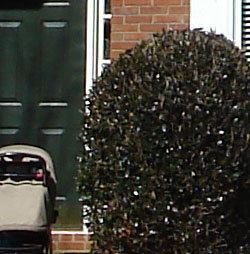
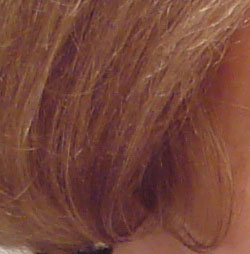
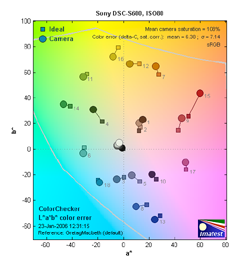

Follow Imaging Resource: